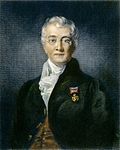Bell's palsy
Bell's palsy is a paralysis of the face on one side. It is caused by inflammation of a facial nerve. The sufferer cannot move the muscles on the affected side of the face.
| Bell's palsy | |
|---|---|
| Classification and external resources | |
 A person attempting to show his teeth and raise his eyebrows with Bell's palsy on his right side (left side of the image). | |
| ICD-10 | G51.0 |
| ICD-9 | 351.0 |
| DiseasesDB | 1303 |
| MedlinePlus | 000773 |
| eMedicine | emerg/56 |
| MeSH | D020330 |
Several conditions can cause facial paralysis, such as brain tumors, strokes, and Lyme disease. Bell's palsy is named after Scottish anatomist Charles Bell. Bell first described the disease. It is the most common acute disease involving only one nerve, and it is the most common cause of sudden facial nerve paralysis.
Bell's palsy involves a rapid start of partial or complete paralysis that often occurs overnight. Scientists believe that inflammation leads to swelling of the facial nerve. The nerve travels through the skull in a narrow bone canal beneath the ear. Nerve swelling and compression in the narrow bone canal are thought to stop the nerve from working. At times of lowered immunity, a dormant (sleeping) virus, usually the chicken pox or cold sore virus, can wake up and attack the nerve causing it to swell.[1] The main symptoms of Bell's palsy are one-sided facial paralysis, jaw pain, dizziness, strengthened hearing in one ear, and weakened taste sense.[2]
Bell's palsy usually cures itself, sometimes in a few weeks. Corticosteroids (cortisone steroids) have been found to improve the condition while anti-viral drugs have not.[3] Early treatment is necessary for steroids or drugs to be effective, but it is controversial wether or not they work. Most people recover spontaneously and achieve near-normal to normal functions. Some people however will never regain full facial movement, or it may take a longer time. Many show signs of improvement as early as 10 days after the onset, even without treatment.
Often those suffering from Bell's palsy cannot open the eye in the affected side. The eye must be protected from drying up, or the cornea may be permanently damaged. The affected eye may need to be taped shut when sleeping.
Bell's Palsy Media
Facial nerve: the facial nerve's nuclei are in the brainstem (represented in the diagram by "θ"). Orange: nerves coming from the left hemisphere of the brain, yellow: nerves coming from the right hemisphere. Note that the forehead muscles receive innervation from both hemispheres (yellow and orange)
Scottish neurophysiologist Sir Charles Bell was the first author to describe the anatomical basis for facial paralysis, and has since served as the eponym for Bell's palsy.
References
- ↑ Sudworth, John 2012. Bell's palsy: Facing the TV cameras with half a smile. BBC News. [1]
- ↑ Bell's Palsy" Health A-to-Z. August 21, 2006 pNA.
- ↑ Sullivan F.M. et al 2007 (2007). "Early treatment with prednisolone or acyclovir in Bell's palsy". N. Engl. J. Med. 357 (16): 1598–607. doi:10.1056/NEJMoa072006. PMID 17942873. S2CID 3916563.

